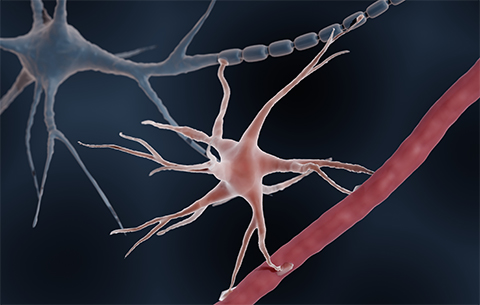From the journals: JLR
Linking astrocyte lipid metabolism to microglia activation. Mathematical models of membrane binding. Read about papers on these topics recently published in the Journal of Lipid Research.
Linking lipid metabolism to microglia activation
Alzheimer’s disease is characterized by neuronal death in response to the accumulation of protein plaques and tangles. However, nonneuronal cells — including microglia and astrocytes — also play a role in Alzheimer’s

Microglia, the resident immune cells of the brain, modulate neuroinflammation often associated with Alzheimer’s and other neurodegenerative diseases. Astrocytes provide metabolic support to neurons and secrete essential lipids in the form of lipoprotein particles. Lipoproteins also contain the apolipoprotein E, or ApoE, a protein with certain alleles linked to Alzheimer’s disease.
Researchers have identified overexpression of the cholesterol-modifying enzyme cholesterol 25-hydroxylase, or CH25H, in the brains of Alzheimer’s patients. In cell culture models, murine microglia also increase expression of the Ch25h gene following inflammatory stimuli and secrete CH25H’s product, 25-hydroxycholesterol, or 25HC. This extracellular 25HC affects both immune cell signaling and neuronal function. However, although astrocytes play a role in lipid metabolism, scientists did not know if CH25H and 25HC regulate activity in this type of glia.
In new work published in the Journal of Lipid Research, Anil G. Cashikar and colleagues from the Washington University School of Medicine and the University of Texas Health Science Center identified a novel role for 25HC in astrocyte function. Although cultured astrocytes did not express detectable levels of the Ch25hgene, the team showed that these cells can take up extracellular 25HC. Also, astrocytes treated with 25HC showed increased secretion of ApoE-containing lipoproteins.
The authors also identified gene expression changes in astrocytes following 25HC treatment, including the upregulation of genes associated with the liver X receptor pathway and lipoprotein secretion and the downregulation of genes associated with sterol regulatory element-binding proteins and cholesterol synthesis.
Finally, the authors examined cholesterol esterification, a process cells typically use to store excess cholesterol. In 25HC-treated astrocytes, both cholesterol ester levels and the number of lipid droplets, a lipid storage organelle, increased.
Collectively, this work suggests 25HC — a lipid product released by microglia in response to inflammation — can modulate astrocytic gene expression and lipoprotein secretion. Although future research is needed in mouse models, the proposed pathway shows promise in the neurodegeneration field.
Mathematical models of membrane binding
Cholesterol — a sterol lipid — is essential for moderating the properties of phospholipid membranes. Cholesterol also interacts with a multitude of membrane proteins and participates in numerous cellular processes.
Researchers often seek to quantify the affinity of proteins for cholesterol. Yet, these measurements usually disregard the fact that most membrane cholesterol is associated with membrane phospholipids, creating competition between proteins and phospholipids for cholesterol. In turn, this complicates the analysis of protein–sterol interactions.
To address this problem, Yvonne Lange of Rush University and a team of researchers created a mathematical model to examine protein and cholesterol binding in phospholipid membranes. Their results were recently published in the Journal of Lipid Research. This model postulates that cholesterol not bound to phospholipids can readily bind proteins. In addition, the model shows that cholesterol bound to phospholipids can be extracted by the protein.
The team validated their model by simulating the binding of the bacterially derived Perfringolysin O protein to membrane cholesterol. Their results matched previously published experimental data using both artificially created liposomes and cellular membranes.
With this new approach, the authors hope to improve understanding of protein–cholesterol interactions and guide new experiments. In particular, this model may benefit researchers working on ligands with a weak affinity for cholesterol, where competition with phospholipids complicates the interpretation of measurements.
Enjoy reading ASBMB Today?
Become a member to receive the print edition four times a year and the digital edition monthly.
Learn moreGet the latest from ASBMB Today
Enter your email address, and we’ll send you a weekly email with recent articles, interviews and more.
Latest in Science
Science highlights or most popular articles

Exploring the link between lipids and longevity
Meng Wang will present her work on metabolism and aging at the ASBMB Annual Meeting, March 7-10, just outside of Washington, D.C.

Defining a ‘crucial gatekeeper’ of lipid metabolism
George Carman receives the Herbert Tabor Research Award at the ASBMB Annual Meeting, March 7–10, just outside of Washington, D.C.

The science of staying strong
Muscles power every movement, but they also tell the story of aging itself. Scientists are uncovering how strength fades, why some species resist it and what lifestyle and molecular clues could help preserve muscle health for life.

Bacteriophage protein could make queso fresco safer
Researchers characterized the structure and function of PlyP100, a bacteriophage protein that shows promise as a food-safe antimicrobial for preventing Listeria monocytogenes growth in fresh cheeses.

Building the blueprint to block HIV
Wesley Sundquist will present his work on the HIV capsid and revolutionary drug, Lenacapavir, at the ASBMB Annual Meeting, March 7–10, in Maryland.

Gut microbes hijack cancer pathway in high-fat diets
Researchers at the Feinstein Institutes for Medical Research found that a high-fat diet increases ammonia-producing bacteria in the gut microbiome of mice, which in turn disrupts TGF-β signaling and promotes colorectal cancer.

